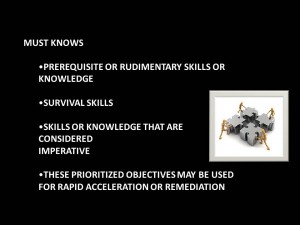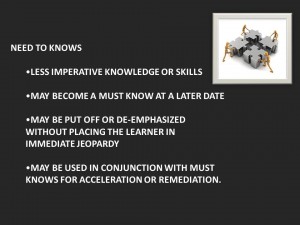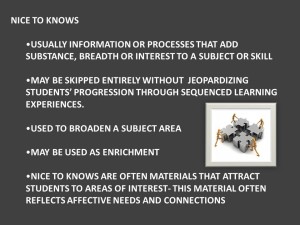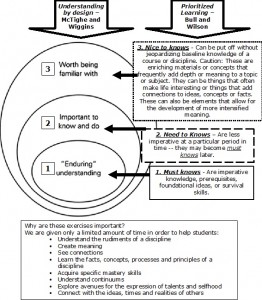Using prioritized objectives to personalize learning
© Leslie Owen Wilson Contact Leslie
There are several common mindsets that can hinder teachers in creating more personalized pathways for individual learners, or for specialized groups of learners. Many of these mindsets result in teachers and students wasting valuable instructional time.
First and foremost, many teachers think that they are responsible for trying to teach everything in a text and/or curriculum. In this mindset some teachers start the year by slowly reviewing baseline, rudimentary skills, or prerequisite materials. Targeted instructional levels are geared toward those students who lack preliminary skills, but not to those students who retained information. For those students who have retained material from previous grades, or who catch on quickly from brief reviews, this approach wastes valuable instructional time. Often it is only after this period of laborious review that new materials or concepts are introduced. A period of pre-assessment at the beginning of the year, followed by appropriate placement or readjustment of curricula, would be a better approach.
Frequently, what happens when teachers review without pre-assessment is that after the first part of the new calendar year they panic because they come to realize that they have not progressed very far into the new material to be covered and time is running out. Unfortunately, the common response is that they simply accelerate the pace of teaching and the speed of presentation. Like a runaway train or bus, the pace of instruction is increasingly accelerated to such a degree that many slower students are simply passed by or left along the way. Teachers using this form of instructional delivery may confidently say that they have “covered” the required material, but the ultimate question is “how many students actually learned the material presented?”
This situation can be avoided by creating simple pre-assessment devices whereby students demonstrate competencies in baseline concepts, rudimentary skills, or prerequisite content. In pre-assessing skills, it may also be helpful to devise opportunities for observation so that you can survey skill levels. With older students you can also employ verbal assessments by giving students lists of skills or content and asking them to indicate mastered concepts, previously learned information, or ask them to discuss knowledge levels, or areas of personal proficiency. If students indicate that they are knowledgeable or proficient in an area, then you can ask them to demonstrate competencies in some meaningful way.
The second common mindset that is a barrier to more personalized instruction is that many teachers are tied to whole class, direct teaching models. Sometimes this occurs because other ways of teaching have never been modeled for them, or they simply do not know how to create more personalized educational experiences through the required content. Unfortunately, this dilemma is often compounded by overly large class sizes.
Methods: How can I do more personalization?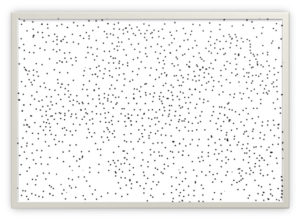
I am not going to pretend that personalizing individual or small group instructional journeys is easy. It is like creating individual dot to dot drawings. However, there are ways that can help create more individualized pathways through curricula. One of those ways is to prioritize teaching goals or objectives. Begin by taking a good long look at your curriculum and/or texts. Say to yourself, “Okay, my time is limited, what can I do effectively? Which concepts or content are essential?
Using the categories and definitions listed below, plus the curriculum scope and sequence for your area, pick and choose the most important concepts, and begin to rank them. Assign a ranking value for each curricular component. This should be done by viewing curriculum as a continuum of more than one grade level. In order to make good instructional decisions, the continuum should include previous grades and following grades. Ideally, teachers practicing prioritizing material should have a sense of the curriculum as a continuum from one grade to another, or from one subject level to another. In creating prioritized objectives or goals, you can accelerate students who have mastered rudimentary skills toward more advanced concepts, or provide remediation for those students who have not mastered baseline skills from pervious units or grades.
Also, students may be held at a particular instructional level, but enriched by being given content at deeper, broader, more complete levels. This process is akin to an instructional planning technique called curriculum compacting, one frequently used with gifted and talented students. But in this process you are applying instructional prioritization so that it creates multiple pathways applicable for all students. This technique can be very helpful in creating IEPs too, or in working with students who need remediation.
Categories: You can call these prioritized objectives anything you like. Here I have designated them as must, need, and nice to knows.
Must Knows:
These are prerequisite or rudimentary skills or knowledge, or survival skills or knowledge, considered imperative to understanding. Must know objectives may be used for rapid acceleration or for remediation.
Need to Knows:
These are less imperative knowledge or skills (this judgment is often based on students’ current grade placement), but they may become a must know at a later date. They may be put off or de-emphasized without placing the learner in immediate jeopardy. Need to knows may be used in conjunction with must knows for purposes of acceleration.
Nice to Knows:
These are usually information or processes that add substance, breadth, or interest to a subject or skill. They may be skipped entirely without jeopardizing students’ progressions through basic skills. Or they can be used to broaden a subject area, or used as enrichment material. In order not to trivialize these concepts, Nice to knows are often materials that attract students to areas of discipline as this material frequently reflects affective needs and emotional connections to particular content or subject areas. However, when time is an issue, these concepts can be put off until later. Nice to knows can also be part of deeper learning experiences.
Use this graphic with the vertical and horizontal arrows below to get an idea how to personalize students’ educational experiences. Students mastering “must knows” can move on to those higher level “must knows” or “need to knows” on the same level. Or, if you want to hold students at the same level, those students mastering “must and need to knows” can be enriched with deeper learning with “nice to knows” or enrichment materials. What you cannot do is just give them more of the same thing! Personalization means you are challenging students with different types of materials and learning tasks, not just making them repeat the same thing over and over again. That is punishment not education. Those students who have mastered concepts need to move on.
In the same way you can accelerate those students who have mastered basic skills, you can remediate those students who need to go back and review or relearn “must knows” before they go on to need or nice to knows. This is why you need to have several levels of curriculum at your disposal. All teachers need to have a sense of the continuum of what they teach in order to be able to accelerate, remediate, or enrich students.
An overall schema of the process looks like this.
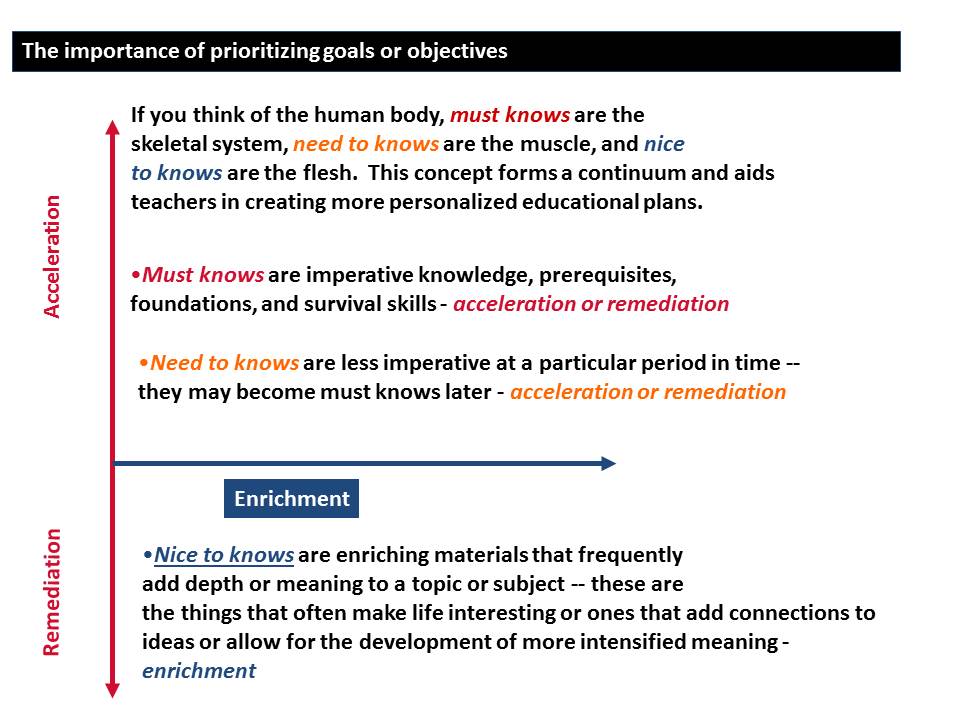
Diagram 1.1 L. O. Wilson
The Progression looks like this
In these times most knowledge is organic and changing. There is very little that is fixed, set in stone, or irrefutable at all levels. Using this method of analyzing curriculum allows educators at any level to engage in meaningful dialogues about what is important to know and understand in today’s world. Both parents and educators need to understand that these types of discussions should take into consideration unknown futures as our children will live in a time much different from our own. What was a priority today, may not be in the near future. We need future citizens who are problem solvers as well as problem finders, ones who can think critically and creatively, ones who are adaptable, investigative, and decisive. And what we need most are parents and teachers who understand and respond to those challenges.

